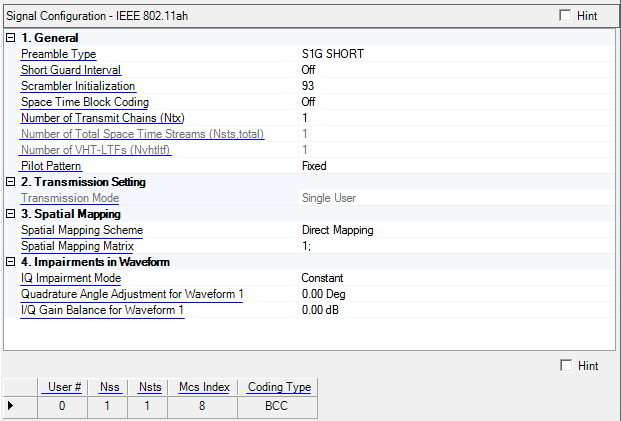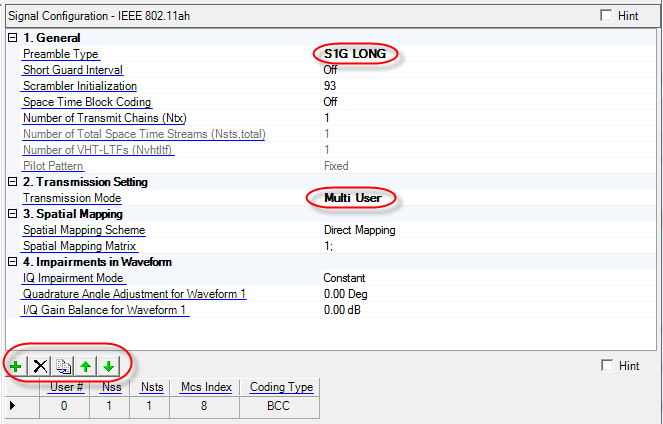
Single User Mode

Multi User Mode

IQ Impairment Mode - Frequency Dependent

Add a new user. The maximum number of user is 4.
Delete a user. The minimum user number is 1.
Add the selected user, and its configuration is copied from the selected user.
Move the selected user up by one row and decrease the user ID by 1
Move the selected user down by one row and increase the user ID by 1
Choice: S1G Short | S1G Long | S1G 1M
Default: S1G Short
Set the type of Preamble.
When the Format is set to S1G and Bandwidth is 1MHz, the preamble type can only be S1G 1M.
When the Format is set to S1G_DUP_1M, the preamble type can only be S1G 1M.
When the Generation Mode is NDP for sounding or NDP for NDP MAC, the preamble type S1G Long is not available.
Choice: On|Off
Default: Off
Determine whether the OFDM symbols adopt the short guard interval which is 400ns. The regular guard interval is 800ns.
Range: 0 to 127
Default: 93
Set the initial state of the scrambler in decimal format, which is then turned into 7 bits to feed into the scrambler. This can be used with either Basic or Advanced capability modes.
Choice: On|Off
Default: Off
Enable/disable space time block coding.
The Space Time Block Coding (STBC) encoder spreads constellation points from Nss spatial stream into Nsts space-time streams using a space-time block code. STBC is used only when Nss <= Nsts.
For each user, its Number of Space Time Streams is equal to its Number of Spatial Streams when the Space Time Block Coding is OFF. Otherwise, its Number of Space Time Streams is twice of its Number of Spatial Streams when the Space Time Block Coding is ON. The default value of Space Time Block Coding is OFF. When a user attempts to turn it ON, the software will check whether this will result in the Number of Total Space Time Streams being greater than the Number of Transmit Chains. If yes, Space Time Block Coding will remain OFF.
Range: 1 to 8
Default: 1
Set the number of transmit chains.
The Number of Transmit Chains is only editable when the selected configuration is IEEE 802.11ac MXN MIMO (1 SG). Otherwise, the cell becomes grey and cannot be edited, and its value is equal to the number of instruments. In this situation, if Channel State is turned On, it will become available again and free to be set.
Displays the total number of space time streams, which equals the sum of the Nsts of each user.
Displays the number of VHT-LTFs.
Table 1 Number of VHT-LTFs required for different numbers of space time streams
|
NSTS,total |
NVHTLTF |
|---|---|
|
1 |
1 |
|
2 |
2 |
|
3 |
4 |
|
4 |
4 |
Choice: Fixed | Traveling
Default: Fixed
Select the type of pilot.
Traveling Pilot is not available in following cases:
1. The Generation Mode is NDP for sounding or NDP for NDP MAC.
2. For S1G MU PPDUs, or S1G SU PPDUs with more than two space-time streams, or S1G SU PPDUs with two space-time streams without STBC.
Choice: Single-user | Multi-user
Default: Single User
When the Capability is Basic and the Generation Mode is, the Transmission Mode will be coupled to be and cannot be changed.
When the Preamble Type is set to S1G Long, this cell is editable. You can select Single User or Multi User.
Choice: Direct Mapping | Spatial Expansion | User defined | Beamforming
Default: Direct Mapping
Set the spatial mapping scheme.
Set the content of the spatial mapping matrix.
If the Spatial Mapping Scheme is Direct Mapping or Spatial Expansion, the content of this matrix is pre-defined and can’t be edited. If the Spatial Mapping Scheme is User Defined or Beamforming, you can edit the matrix. When the editing is done, the content of the matrix will be saved for generating the next waveform.
Choice: Constant | Frequency Dependent
Default: Constant
Select the IQ impairment mode. Each mode has a unique pair of impairment adjustments.
Constant -- IQ impairment is independent of frequency.
Frequency Dependent -- IQ impairment is a function of frequency with vector impairment adjustments applied to subcarriers.
This feature is only available for 802.11n with Option H and 802.11ac.
Use this cell to add quadrature skew impairment (-90 to + 90 degrees) to the generated waveform for the specific signal generator. This affects the waveform data so it applies to both RF and baseband I/Q outputs. This parameter is only available when the IQ Impairment Mode is set to Constant.
The baseband Quadrature Angle (angle) and the baseband IQ Gain (gain) values are used to modify the output I and Q data according to the following equations:
Real (output) = Real (input) - Gs * Imag (input)
Imag (output) = Gc * Imag (input)
where:
Gs = Gain * sin (angle) and
Gc = Gain * cos (angle)
Use this cell to add quadrature gain impairment (-10 dB to 10 dB) to the generated waveform for the specific signal generator. This affects the waveform data so it applies to both the RF and baseband I/Q outputs. This parameter is only available when the IQ Impairment Mode is set to Constant.
Default: all zeros
This is a vector with a maximum length of 512. Click  in the parameter field to open a
in the parameter field to open a ![]() window where you can specify the quadrature angle for every subcarrier in the OFDM signal. ‘n’ specifies the index of the antenna. When you click on the button at the rightmost side of the field, a window appears, allowing you enter a phase error for each subcarrier. This parameter is only available when the IQ Impairment Mode is set to Frequency Dependent.
window where you can specify the quadrature angle for every subcarrier in the OFDM signal. ‘n’ specifies the index of the antenna. When you click on the button at the rightmost side of the field, a window appears, allowing you enter a phase error for each subcarrier. This parameter is only available when the IQ Impairment Mode is set to Frequency Dependent.
Default: all zeros
This is a vector with a maximum length of 512. Click  in the parameter field to open a
in the parameter field to open a ![]() window where you can specify the in-phase gain for every subcarrier in the OFDM signal. ‘n’ specifies the index of the antenna. When you click on the button at the rightmost side of the field, a window appears, allowing you enter a phase error for each subcarrier. This parameter is only available when the IQ Impairment Mode is set to Frequency Dependent.
window where you can specify the in-phase gain for every subcarrier in the OFDM signal. ‘n’ specifies the index of the antenna. When you click on the button at the rightmost side of the field, a window appears, allowing you enter a phase error for each subcarrier. This parameter is only available when the IQ Impairment Mode is set to Frequency Dependent.
Range: 0 to 3
Default: 0
Displays the User index. When a new user is added or deleted, the user # will increment or decrement by 1.
Displays the Number of Spatial Streams (Nss,u).
Displays the Number of Space Time Streams (Nsts,u).
Displays the MCS Index.
Displays the Channel Coding Mode.